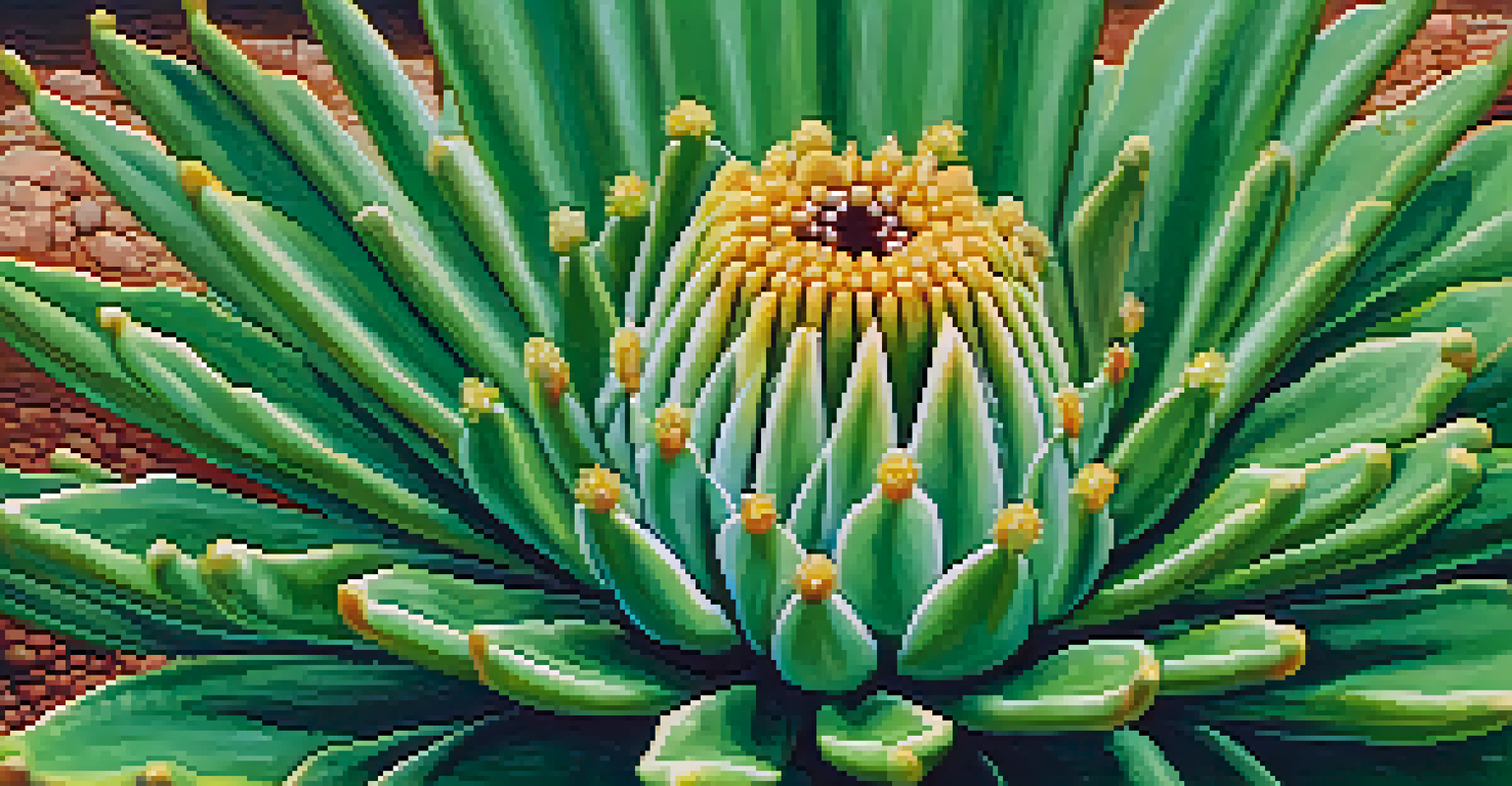Exploring Peyote: A Path to Healing in Sacred Spaces

Understanding Peyote: The Sacred Cactus
Peyote, a small cactus native to Mexico and the southwestern United States, has been used for centuries in various indigenous cultures. Known scientifically as Lophophora williamsii, it contains mescaline, a psychoactive compound that induces profound spiritual experiences. These experiences often lead to a deeper understanding of oneself and the universe, making peyote a vital part of many healing rituals.
The greatest discovery of my generation is that a human being can alter his life by altering his attitude of mind.
Traditionally, peyote is consumed during ceremonies led by a shaman or healing guide, who facilitates the experience and ensures the safety of participants. The cactus has deep cultural significance, often regarded as a teacher or a bridge to spiritual realms. This connection to nature and the divine highlights the importance of respecting and honoring these practices.
In recent years, interest in peyote has grown beyond indigenous communities, with many seeking alternative healing methods. However, it is crucial to approach this sacred plant with respect and understanding, recognizing its cultural roots and the wisdom it embodies.
The Role of Peyote in Indigenous Healing Traditions
For many Native American tribes, peyote serves as a central element in spiritual and healing practices. The Native American Church, which combines Christianity with traditional beliefs, uses peyote in its ceremonies to promote healing, unity, and spiritual growth. Participants often report experiencing visions that provide insight into personal challenges and collective issues faced by their communities.

Peyote ceremonies typically involve singing, drumming, and communal prayers, creating a supportive environment for healing. This group dynamic fosters a sense of belonging and shared purpose, essential for emotional and spiritual recovery. The process encourages participants to confront their fears and traumas in a safe space, guided by the wisdom of the peyote and the community.
Peyote's Cultural Significance
Peyote is deeply rooted in indigenous traditions, serving as a sacred tool for spiritual healing and community connection.
Additionally, the integration of peyote in healing rituals reflects a holistic approach to wellness, addressing physical, emotional, and spiritual aspects. As more people seek to reconnect with nature and their inner selves, understanding these traditions becomes increasingly important.
Psychoactive Properties of Peyote: Healing Through Experience
The primary psychoactive compound in peyote, mescaline, has been studied for its potential therapeutic benefits. Users often report feelings of interconnectedness, heightened emotional awareness, and profound insights during their experiences. These effects can lead to significant personal transformations, helping individuals confront and heal from past traumas.
The mind is everything. What you think you become.
Research has shown that psychedelics, including mescaline, may have potential in treating various mental health conditions, such as depression and anxiety. The therapeutic use of peyote in controlled settings can provide a safe environment for individuals to explore their emotions and experiences, often resulting in lasting positive changes. This aligns with the growing interest in integrating psychedelics into modern therapeutic practices.
However, it is essential to approach these experiences with caution and respect, recognizing the need for guidance from experienced practitioners. The combination of setting, intention, and support plays a crucial role in the healing process, ensuring that individuals can navigate their journeys safely.
The Importance of Sacred Spaces in Peyote Ceremonies
Sacred spaces play a pivotal role in peyote ceremonies, providing an environment conducive to healing and spiritual exploration. These spaces are often chosen for their natural beauty and tranquility, allowing participants to connect deeply with nature. The atmosphere created in these settings encourages introspection and openness, essential for meaningful experiences.
Creating a sacred space involves more than just location; it encompasses intention, rituals, and the presence of a community. Participants are encouraged to leave behind distractions and focus on their inner journeys. This intentionality fosters a sense of safety and belonging, crucial for effective healing.
Therapeutic Benefits of Mescaline
Research suggests that mescaline, the psychoactive compound in peyote, may offer therapeutic benefits for mental health challenges.
Moreover, the use of sacred spaces reflects the belief that nature itself is a healing force. By immersing oneself in the natural world, individuals can tap into a deeper understanding of their place within it, ultimately leading to a more profound sense of peace and clarity.
Challenges and Misunderstandings Surrounding Peyote Use
Despite its rich cultural heritage, the use of peyote is often misunderstood and stigmatized. Many people associate it solely with recreational drug use, overlooking its sacred significance and traditional applications. This misunderstanding has led to legal challenges and restrictions that can hinder indigenous practices and the preservation of cultural traditions.
Additionally, the increasing popularity of psychedelics in mainstream culture raises concerns about cultural appropriation. As more individuals seek experiences with peyote outside of its traditional context, it’s vital to recognize and honor the communities that have safeguarded this sacred plant for generations. Engaging with these traditions respectfully is essential to avoid exploitation.
These challenges highlight the need for education and awareness regarding the cultural significance of peyote. By fostering a deeper understanding of its traditional uses and the wisdom behind them, we can help bridge the gap between indigenous practices and contemporary interest in healing.
Peyote and Modern Mental Health Practices
As interest in alternative healing methods grows, peyote is increasingly being explored within the context of modern mental health practices. Therapists and researchers are examining the potential benefits of integrating peyote experiences into therapeutic frameworks, particularly for individuals struggling with trauma, PTSD, and addiction. The insights gained from peyote can complement traditional talk therapies, offering new avenues for healing.
However, this integration requires careful consideration of ethical practices and cultural sensitivity. Mental health professionals must prioritize collaboration with indigenous communities to ensure that the use of peyote respects its traditional significance. This partnership can create a more holistic approach to mental health, blending ancient wisdom with contemporary therapeutic techniques.
Preservation of Peyote Practices
The future of peyote relies on respecting indigenous practices while addressing environmental concerns and promoting sustainable use.
Ultimately, the exploration of peyote within modern mental health practices represents a significant shift in how we view healing. By valuing both traditional and contemporary approaches, we can create a more inclusive and effective path to wellness for individuals seeking support.
The Future of Peyote: Preservation and Respect
As interest in peyote continues to grow, it is essential to focus on its preservation and the respect of indigenous practices. Overharvesting and habitat loss pose significant threats to peyote populations, making conservation efforts critical. Supporting sustainable practices and advocating for the rights of indigenous communities are vital steps in ensuring the future of this sacred plant.
Additionally, education plays a crucial role in fostering respect for peyote and its cultural significance. By sharing knowledge about its traditional uses and the experiences of indigenous peoples, we can cultivate a deeper appreciation for the plant and its role in healing. This understanding can also help counteract misconceptions and stigma surrounding peyote use.

Ultimately, the future of peyote lies in a balanced approach that honors its cultural roots while allowing for exploration and growth. By working together to protect and respect this sacred plant, we can ensure its legacy as a powerful tool for healing and spiritual connection.